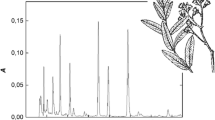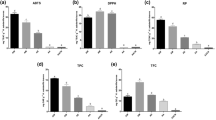Abstract
The antioxidant activity (AA), total phenolic content (TPC) and total flavonoids content (TFC) in Dong quai (DQ, Angelica sinensis) raw materials and dietary supplements (DS) containing this plant were determined using the CUPRAC, FRAP and fluorescence methods. The antioxidant activity for DQ aqueous extracts revealed by CUPRAC was (1330.45 ± 1.30) μmol Trolox equivalent (TE) per 100 g of dry mass (DM), whereas the antioxidant activity as determined by FRAP was (1813.9 ± 2.0) μmol of TE per 100 g of DM. Lower values were noted for the fluorescence method than for CUPRAC and FRAP (ranging from (35.96 ± 0.3) to (304.6 ± 1.4) μmol of TE per 100 g of DM). The highest TPC values were determined for an aqueous extract of DQ ((3330.3 ± 2.3) μmol of TE per 100 g of DM), while TFC for ethanolic extracts of DQ was ((146.50 ± 0.5) mg of quercetin equivalent (QE) per 100 g of DM). Cinnamic acid, isomers of benzoic acid and derivatives of quercetin were analysed by HPLC-PDA. The ferulic acid concentration in an ethanolic extract of DQ was (21.83 ± 0.07) mg per 100 g of DM. Of the flavonols detected, rutin exhibited the highest concentration in ethanolic extract of DQ ((3.32 ± 0.13) mg of QE per 100 g of DM). Other phytochemicals (alkaloids, saponins, flavonoids, anthraquinones, tannins, steroids, etc.) were identified by phytoscreening colour reaction. The results were analysed by principal component analysis (PCA), cluster analysis and one-way ANOVA tests.
Similar content being viewed by others
References
Apak, R., Güçlü, K., Özyürek, M., & Çelik, S. E. (2008). Mechanism of antioxidant capacity assays and the CUPRAC (cupric ion reducing antioxidant capacity) assay. Microchimica Acta, 160, 413–419. DOI: 10.1007/s00604-007-0777-0.
Circosta, C., De Pasquale, R., Palumbo, D. R., Samperi, S., & Occhiuto, F. (2006). Estrogenic activity of standardized extract of Angelica sinensis. Phytotherapy Research, 20, 665–669. DOI: 10.1002/ptr.1928.
Cisowski, W. (1995). Analiza fitochemiczna. Gdańsk, Poland: Akademia Medyczna w Gdańsku. (in Polish)
Clifford, M. N. (2004). Diet-derived phenols in plasma and tissues and their implications for health. Planta Medica, 70, 1103–1114. DOI: 10.1055/s-2004-835835.
Cook, N. C., & Samman, S. (1996). Flavonoids — chemistry, metabolism, cardioprotective effects and dietary sources. The Journal of Nutritional Biochemistry, 7, 66–76. DOI: 10.1016/s0955-2863(95)00168-9.
Filipiak-Szok, A., Kurzawa, M., & Szłyk, E. (2012a). Determination of antioxidant capacity and content of phenols, phenolic acids and flavonols contents in Indian and European gooseberry. Chemical Papers, 66, 259–268. DOI: 10.2478/s11696-012-0151-5.
Filipiak-Szok, A., Piasta, A., Kurzawa, M., & Szłyk, E. (2012b). Determination of flavonols and phenolic acids in Puearia lobata (Kudzu) root by HPLC-PDA method. Current Issues in Pharmacy and Medical Sciences, 25, 278–281.
Ho, C. C., Kumaran, A., & Hwang, L. S. (2009). Bio-assay guided isolation and identification of anti-Alzheimer active compounds from the root of Angelica sinensis. Food Chemistry, 114, 246–252. DOI: 10.1016/j.foodchem.2008.09.046.
Huang, L. F., Li, B. Y., Liang, Y. Z., Guo, F. Q., & Wang, Y. L. (2004). Application of combined approach to analyze the constituents of essential oil from Dong quai. Analytical and Bioanalytical Chemistry, 378, 510–517. DOI: 10.1007/s00216- 003-2309-z.
Huang, S. H., Chen, C. C., Lin, C. M., & Chiang, B. H. (2008). Antioxidant and flavor properties of Angelica sinensis extracts as affected by processing. Journal of Food Composition and Analysis, 21, 402–409. DOI: 10.1016/j.jfca.2008.02.005.
Lafay, S., & Gil-Izquierdo, A. (2008). Bioavailability of phenolic acids. Phytochemistry Reviews, 7, 301–311. DOI: 10.1007/s11101-007-9077-x.
Lao, S. C., Li, S. P., Kan, K. K. W., Li, P., Wan, J. B., Wang, Y. T., Dong, T. X., & Tsim, K. W. K. (2004). Identification and quantification of 13 components in Angelica sinensis (Danggui) by gas chromatography-mass spectrometry coupled with pressurized liquid extraction. Analytica Chimica Acta, 526, 131–137. DOI: 10.1016/j.aca.2004.09.050.
Li, P., Li, S. P., Lao, S. C., Fu, C. M., Kan, K. K. W., & Wang, Y. T. (2006). Optimization of pressurized liquid extraction for Z-ligustilide, Z-butylidenephthalide and ferulic acid in Angelica sinensis. Journal of Pharmaceutical and Biomedical Analysis, 40, 1073–1079. DOI: 10.1016/j.jpba.2005.08.035.
Lu, G. H., Chan, K., Leung, K., Chan, C. L., Zhao, Z. Z., & Jiang, Z. H. (2005). Assay of free ferulic acid and total ferulic acid for quality assessment of Angelica sinensis. Journal of Chromatography A, 1068, 209–219. DOI: 10.1016/j.chroma.2005.01.082.
Mei, Q. B., Tao, J. Y., & Cui, B. (1991). Advances in the pharmacological studies of radix Angelica sinensis (Oliv) Diels (Chinese Danggui). Chinese Medical Journal, 104, 776–781.
Novas, M. J., Jimenez, A. M., & Asuero, A. G. (2004). Determination of antioxidant activity of Canary seed infusions by chemiluminescence. Journal of Analytical Chemistry, 59, 75–77. DOI: 1061-9348/04/5901-0075.
Pharmacopoeia Commission (1988). Pharmacopoeia of the People’s Republic of China 2000 (English edition, pp. 106–107). Guangzhou, China: Guandong Science and Technology Press.
Pharmacopoeia Commission (2000). Pharmacopoeia of the People’s Republic of China 2000 (English edition, pp. 158). Beijing, China: Chemical Industry Press.
Pogačnik, L., & Ulrih, N. P. (2012) Application of optimized chemiluminescence assay for determination of the antioxidant capacity of herbal extracts. Luminescence, 27, 505–510. DOI: 10.1002/bio.1384.
Polskie Towarzystwo Farmaceutyczne (2002). Farmakopea Polska. (4th ed.) Warsawa, Poland: Polskie Towarzystwo Farmaceutyczne. (in Polish)
Ross, I. A. (2001). Angelica sinensis. In Medicinal plants of the world (pp. 67–79). Totowa, NJ, USA: Humana Press. DOI: 10.1007/978-1-59259-237-1 5.
Senthamarai, R., Ismail, A. M., Kiurbha, T. S. V., & Balasubramanian, P. (2012). Pharmacognostical and phytochemical studies on leaves of Stephania japonica Linn. Journal of Chemical and Pharmaceutical Research, 4, 1457–1464.
Shou, C., Li, J., & Liu, Z. (2011). Complementary and alternative medicine in the treatment of menopausal symptoms. Chinese Journal of Integrative Medicine, 17, 883–888. DOI: 10.1007/s11655-011-0932-7.
Song, G. X., Deng, C. H., Wu, D., & Hu, Y. M. (2004). Headspace solid-phase microextraction-gas chromatographic- mass spectrometric analysis of the essential oils of two traditional chinese medicines, Angelica pubescens and Angelica sinensis. Chromatographia, 59, 343–349. DOI: 10.1365/s10337-003-0175-7.
Sun, Y. L., Tang, J., Gu, X. H., & Li, D. Z. (2005), Water-soluble polysaccharides from Angelica sinensis (Oliv.) Diels: Preparation, characterization and bioactivity. International Journal of Biological Macromolecules, 36, 283–289. DOI: 10.1016/j.ijbiomac.2005.07.005.
Szajdek, A., & Borowska, E. J. (2008). Bioactive compounds and health-promoting properties of berry fruits: a review. Plant Foods for Human Nutrition, 63, 147–156. DOI: 10.1007/s11130-008-0097-5.
Upton, R. (2003). American herbal pharmacopoeia and therapeutic compendium: Dang Gui root — Angelica sinensis (Oliv.) Diels. Scotts Valley, CA, USA: American Herbal Pharmacopoeia.
Wang, S., Maa, H. Q., Sunc, Y. J., Qiao, C. D., Shao, S. J., & Jiang, S. X. (2007). Fingerprint quality control of Angelica sinensis (Oliv.) Diels by high-performance liquid chromatography coupled with discriminant analysis. Talanta, 72, 434–436. DOI: 10.1016/j.talanta.2006.11.006.
Weng, C. J., & Yen, G. C. (2012). Chemopreventive effects of dietary phytochemicals against cancer invasion and metastasis: Phenolic acids, monophenol, polyphenol, and their derivatives. Cancer Treatment Reviews, 38, 76–87. DOI: 10.1016/j.ctrv.2011.03.001.
Wojcikowski, K., Wohlmuth, H., Johnson, D. W., Rolfe, M., & Gobe, G. (2009). An in vitro investigation of herbs traditionally used for kidney and urinary system disorders: Potential therapeutic and toxic effects. Nephrology, 14, 70–79. DOI: 10.1111/j.1440-1797.2008.01017.x.
Zhao, K. J., Dong, T. T. X., Tu, P. F., Song, Z. H., Lo, C. K., & Tsim, K. W. K. (2003). Molecular genetic and chemical assessment of radix Angelica (Danggui) in China. Journal of Agricultural and Food Chemistry, 51, 2576–2583. DOI: 10.1021/jf026178h.
Author information
Authors and Affiliations
Corresponding author
Rights and permissions
About this article
Cite this article
Filipiak-Szok, A., Kurzawa, M. & Szłyk, E. Evaluation of antioxidants in Dong quai (Angelica sinensis) and its dietary supplements. Chem. Pap. 68, 493–503 (2014). https://doi.org/10.2478/s11696-013-0485-7
Received:
Revised:
Accepted:
Published:
Issue Date:
DOI: https://doi.org/10.2478/s11696-013-0485-7




